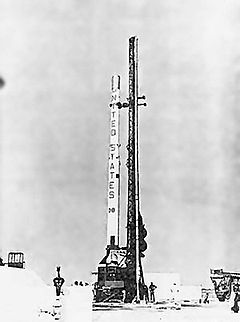
Mercury-Scout 1
Encyclopedia

Project Mercury
In January 1960 NASA awarded Western Electric Company a contract for the Mercury tracking network. The value of the contract was over $33 million. Also in January, McDonnell delivered the first production-type Mercury spacecraft, less than a year after award of the formal contract. On February 12,...
flights. It grew out of a May 5, 1961 NASA
NASA
The National Aeronautics and Space Administration is the agency of the United States government that is responsible for the nation's civilian space program and for aeronautics and aerospace research...
proposal to use Scout rockets to launch small satellites to evaluate the worldwide Mercury Tracking Network
Manned Space Flight Network
The Manned Space Flight Network was a set of tracking stations built to support the American space efforts of Mercury, Gemini, Apollo and Skylab...
in preparation for manned orbital missions. The launch of Mercury-Scout 1 on November 1, 1961 was unsuccessful, and the satellite failed to achieve orbit.
Background
The Mercury Tracking Network was a series of U.S. owned and operated ground stations and tracking ships, positioned around the world under the flightpath of Mercury spacecraft. When the spacecraft came within several hundred miles of a ground station, it could have line-of-sight voice and telemetry communications by HF (shortwave), VHF or UHF radio and C-band and S-band radar. These communications passes would only last a few minutes, until the ground station disappeared over the horizon. Between ground stations, Mercury spacecraft were out of communications, except for an occasional unreliable HF message. In the early 1960s there were no synchronous communications satellites. The ground stations were linked back to NASA's Mercury Control in Florida through land lines, undersea cables and in some cases HF radio.The concept was approved on May 24. On June 13 the NASA Space Task Group issued requirements for a modified Scout rocket and small communications satellite that became known as Mercury-Scout. The satellite would simulate a Mercury spacecraft, allowing testing of and training with the Mercury Tracking Network.
Minitrack
The Minitrack Network, was the first U.S. satellite tracking network to become operational, in 1957. It was used to track the flights of Sputnik, Vanguard, Explorer, and other early space efforts...
beacons, two telemetry transmitters, an S- and C-band beacon, and antennas; all powered by a 1500 watt-hour battery. Also attached was the fourth stage instrument package. The battery could power the electronics for 18½ hours before running down. To extend the satellite life, the equipment would be powered off by a ground command after the first three orbits (5 hours). During power-down, data results would be analyzed. The satellite would then be powered up for another three orbits (5 more hours). This process would then be repeated a third time. Mercury planners thought that by shutting down and powering up the satellite, the Mercury Tracking Network would get data and experience from the equivalent of three Mercury orbital missions.
NASA decided to modify a USAF Blue-Scout II, # D-8, for the first Mercury-Scout mission. The U.S. Air Force was already launching Blue Scout rockets from Cape Canaveral
Cape Canaveral Air Force Station
Cape Canaveral Air Force Station is an installation of the United States Air Force Space Command's 45th Space Wing, headquartered at nearby Patrick Air Force Base. Located on Cape Canaveral in the state of Florida, CCAFS is the primary launch head of America's Eastern Range with four launch pads...
and launched this one as well.
Mercury-Scout 1 was launched on November 1, 1961, from LC-18B
Cape Canaveral Air Force Station Launch Complex 18
Launch Complex 18 is a launch complex at the Cape Canaveral Air Force Station, Florida that was active during the late 1950s and early 1960s. It was used by Viking, Vanguard, Thor and Scout rockets...
. Twenty-eight seconds after liftoff, the Blue Scout II first stage failed. The rocket was destroyed by the Range Safety Officer after 44 seconds of flight.
NASA canceled further Mercury-Scout missions; by the time Mercury-Scout 1 was launched, the MA-4
Mercury-Atlas 4
Mercury-Atlas 4 was an unmanned spaceflight of the Mercury program. It was launched on September 13, 1961 at 14:09 UTC from Launch Complex 14 at Cape Canaveral, Florida. A Crewman Simulator instrument package was aboard. The craft orbited the Earth once....
and MA-5
Mercury-Atlas 5
Mercury-Atlas 5 was an American unmanned spaceflight of the Mercury program. It was launched on November 29, 1961 with Enos the Chimp, a chimpanzee, aboard...
missions had already orbited and checked out the Mercury Tracking Network.
Blue Scout II parameters
| Parameter | 1st Stage | 2nd Stage | 3rd Stage | 4th Stage |
|---|---|---|---|---|
| Gross Mass | 10,705 kg | 4,424 kg | 1,225 kg | 238 kg |
| Empty Mass | 1,900 kg | 695 kg | 294 kg | 30 kg |
| Thrust | 470 kN | 259 kN | 60.5 kN | 12.4 kN |
| Isp | 214 s (2.10 kNs/kg) | 262 s (2.57 kNs/kg) | 256 s (2.51 kNs/kg) | 256 s (2.51 kNs/kg) |
| Burn time | 40 s | 37 s | 39 s | 38 s |
| Length | 9.12 m | 6.04 m | 3.38 m | 1.83 m |
| Diameter | 1.01 m | 0.79 m | 0.78 m | 0.46 m |
| Engine: | Aerojet General Algol 1 | Thiokol XM33 (TX-354-3) Castor Castor (rocket stage) The Castor family of solid-fuel rocket stages and boosters were built by Thiokol and used on a variety of launch vehicles. They were initially developed as the second stage motor of the Scout rocket... 2 |
Allegany Ballistics Lab X-254 Antares 1A | Allegany Ballistics Lab X-248 Altair 1 |
| Propellant | Solid Fuel | Solid Fuel | Solid Fuel | Solid fuel |
- Total length: 21.65 m
- Finspan: 2.84 m
LEO payload
- Mass: 30 kg
- To: 300 km orbit
- Att: 28.0 degrees
- Apogee: 2,500 km

